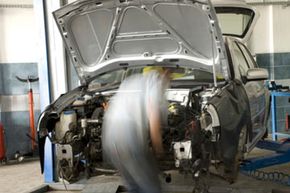Key Takeaways
- Chop shops dismantle stolen cars and sell their parts for profit, often tied to organized crime syndicates.
- Mechanics quickly dismantle cars into components, focusing on selling body panels over engine parts.
- Chop shops use various methods to hide the identity of stolen cars, such as re-Vinning and exporting them to foreign markets.
Every 40 seconds, a car or truck is stolen in the United States, adding up to a total of just less than 800,000 stolen vehicles a year. In 2009, 258 of every 100,000 cars were stolen [source: Insurance Information Institute]. But while some of those cars are stolen by criminals for their own transportation, and others are stolen by teenagers looking for a joyride, many are lifted by professional thieves. Instead of dumping the cars when the ride is over, these pros take them to chop shops, illegal garages where mechanics dismantle cars and sell them for parts. It's difficult to determine how many stolen cars are taken by professional thieves. Recent estimates put the figure at around 25 percent [source: National Highway Traffic Safety Administration].
The professionalization of car theft began in the '70s, when organized crime syndicates began to take over the business of car theft from the amateurs. Car thefts reached epidemic levels during that decade. In 1978, for example, 1 million cars were stolen in the United States [source: U.S. Senate]. It was then that illegal chop shops began opening up across the country, eventually prompting Congressional hearings and a series of federal laws aimed at stopping the new trend. In 1970s New York City, the NYPD estimated that 55 percent of all cars stolen in the city ended up chopped for parts [source: U.S. Senate].
Advertisement
Car thefts have actually trended downward in the United States over the past three decades. In 2006, cars were stolen as often as every 26 seconds, but thefts were actually down 17 percent from 2008 to 2009 [source: Insurance Information Institute].
However, despite law enforcement efforts, chop shops are still alive and well in the United States, Canada, Latin America, Europe and Japan. In the United States, only 12.4 percent of stolen car cases are closed each year, and many of the cars that aren't found end up in professional car theft rings [source: Insurance Information Institute]. Of course, it's impossible to say how many of those missing vehicles end up chopped for parts. If the authorities knew what happened to them, more cases would be closed.
So what exactly is the purpose of a chop shop? In a nutshell they hide the identity of stolen cars and quickly turn them around and sell them for profit. Some are run independently, and some are part of larger criminal networks like gangs and the mafia. Read on to find out how these illegal chop shops can turn a stolen car into cold hard cash in a matter of a few hours.
Advertisement



